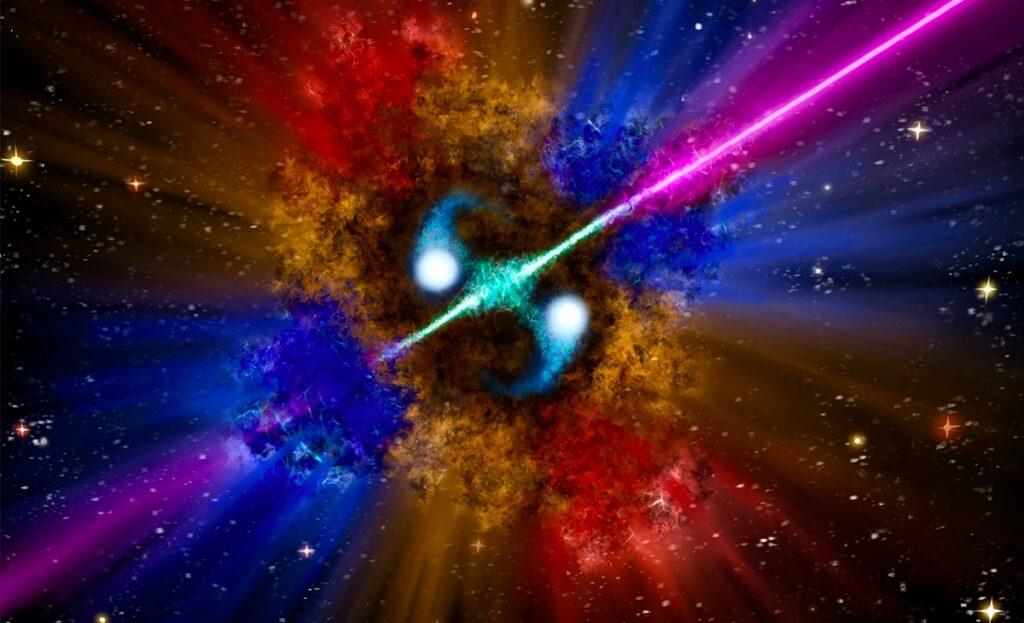On December 11, 2021, the Neil Gehrels Swift Observatory satellite observed a gamma-ray burst, named GRB 211211A that is one of the brightest ever observed. Then, ground-based and space-based telescopes started to follow up GRB 211211A to obtain images at different wavelengths.
Gamma-ray bursts (GRB) are considered to be among the most catastrophic and energetic events in the Universe since they can release in few fractions of seconds the entire energy emitted by a star like the Sun throughout its entire life. They usually are classified into long and short duration gamma-ray emissions. The long duration GRB typically are associated with massive star collapse (supernovae) and last more than two seconds, while the short duration GRBs were previously thought to only occur when two compact objects – like two neutron stars or a neutron star and a black hole – collide to form a kilonova.
GRB 211211A found to be a long duration GRB, however the images in the optical light showed a kilonova similar to the one observed together with GW 170817, the gravitational wave event following the merger between two neutron stars observed on Earth in 2017.

In addition to the initial burst, this phenomenon produces high-energy gamma-ray emission, starting several minutes after the Swift satellite detection and lasting a few hours. This emission is detected by the Large Area Telescope (LAT) onboard the Fermi satellite. GSSI researchers studied the data gathered by Fermi-LAT. They proposed an interpretation of this phenomenon, as explained in their recent paper published in Nature, whose corresponding author is Alessio Mei, a Ph.D. student at GSSI and INFN associate.
“GRB 211211A showed a high energy gamma-ray flux several minutes after the merger of two neutron stars, and it lasted a few hours. We expected this GRB late-time emission, the so-called afterglow, to weaken over time. To our great surprise, the flux remained constant longer”, Mei explains.
This high-energy gamma-ray emission was revealed to be brighter and more prolonged than predicted by state-of-the-art afterglow models, pushing the researchers to explore new scenarios. Biswajit Banerjee, a Post-Doctoral researcher at GSSI and an INFN associate, explains that “the afterglow emission can be interpreted as the interaction between an ultra-relativistic jet, made by particles traveling almost at the speed of light, and the interstellar medium. What we saw with the telescope was never observed before, and the ultra-relativistic jet alone could not explain it. We needed to find a new source of emission”.

Considering the kilonova emission as the new emission source was a turning point. This high-energy gamma-ray excess can be explained by the interaction between the electrons accelerated in a relativistic jet, following the main ultra-relativistic one, and the same kilonova light.
“All the data gathered using several facilities, such as the XMM-Newton telescope in the X-ray band, the Telescopio Nazionale Galileo in the optical band, and the Very Large Array antennas in the radio band, gave a fundamental contribution in developing the advanced theoretical model behind GRB 211211A” adds Om Sharan Salafia, a researcher at the University of Milan Bicocca and INAF associate researcher.
“Among all the new questions posed by GRB 211211A, we should concentrate on understanding how a binary neutron star merger can produce a long duration GRB such as this case, whereas before we thought they could produce only short duration ones” comments Giancarlo Ghirlanda, a researcher at INAF- Osservatorio di Merate.
“This discovery opens to new astonishing possibilities for multi-messenger astronomy, new gravitational waves counterparts to search in the high energy gamma-ray band, and new ways to explore the mighty engine that produces a GRB as well as the interaction between the jet and slower material which gives origin to the heaviest elements in the Universe”, concludes Marica Branchesi, GSSI professor and INFN research associate.
The paper entitled “Gigaelecronvolt emissions from a compact binary merger” with lead author Alessio Mei (Gran Sasso Science Institute e INFN – Laboratori Nazionali del Gran Sasso) has been accepted for publication in the Nature journal on 7th of December, 2022. The paper can be found here: https://www.nature.com/articles/s41586-022-05404-7 . The co-authors of this work are: Biswajit Banerjee (INFN – Laboratori Nazionali del Gran Sasso), Gor Oganesyan (Gran Sasso Science Institute e INFN – Laboratori Nazionali del Gran Sasso); Om Sharan Salafia (Università degli Studi di Milano-Bicocca e INAF – Osservatorio Astronomico di Brera); Stefano Giarratana (Department of Physics and Astronomy, University of Bologna e INAF – Istituto di Radioastronomia); Marica Branchesi (Gran Sasso Science Institute e INFN – Laboratori Nazionali del Gran Sasso); Paolo D’Avanzo (INAF – Osservatorio Astronomico di Brera); Sergio Campana (INAF – Osservatorio Astronomico di Brera); Giancarlo Ghirlanda (Università degli Studi di Milano-Bicocca e INAF – Osservatorio Astronomico di Brera); Samuele Ronchini (Gran Sasso Science Institute e INFN – Laboratori Nazionali del Gran Sasso); Amit Shukla (Department of Astronomy, Astrophysics and Space Engineering, Indian Institute of Technology Indore); Pawan Tiwari (Department of Astronomy, Astrophysics and Space Engineering, Indian Institute of Technology Indore).
This work was partially supported by the European Union Horizon 2020 Programme under the AHEAD2020 project (grant agreement number 871158).
Source: https://www.gssi.it/communication/news-events/item/20826-sorprendenti-lampi-gamma-ad-alta-energia-dalla-fusione-di-due-stelle-di-neutroni.
